
FODMers Participated in the Environment Expo
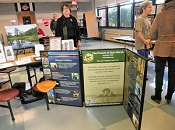
The Friends of Dyke Marsh exhibited at Fairfax County Board of Supervisors’ Mount Vernon Supervisor Dan Storck’s Environment Expo on November 10, 2018, an event which Supervisor Storck hopes to hold again. Over 130 people attended and were inspired to become better environmental stewards in eight workshops and in watching the movie “Hometown Habitat.”
Breakwater’s Base Being Built
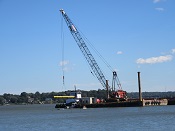
In mid-October 2018, crews from Coastal Design and Construction continue to build a breakwater in Dyke Marsh to help stop erosion and encourage sedimentation, the first stage of marsh restoration. As of October 17, 2:30 p.m., the team had installed three layers of “marine mattresses” or 1,624 units. The total final number will depend on the depth of the river bottom. A new barge load will arrive soon.
Planting Again to Restore Habitat with Native Plants
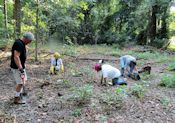
On October 4, 2018, ten dedicated FODM volunteers and National Park Service staffers put in another 400 or so plants in our native plant demonstration area along the west side of the Haul Road trail, bringing our total plantings this year to around 3,500. Despite the oppressive heat and a “healthy population” of mosquitoes, “It was a true labor of love,” said Ned Stone, FODM Vice President.
Volunteers Collect 50 Bags of Never-ending Trash
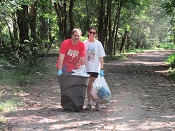
The Friends of Dyke Marsh and the National Park Service hosted 35 volunteers, ages five to unknown, who collected 50 big bags of trash for three hours along the Potomac River and Dyke Marsh shoreline during low tide on September 22.
How Plants Support Insects, Birds and other Wildlife

Dr. Desiree Narango, an ecologist, gave a presentation to 70 people on September 12, 2018, explaining how native and non-native plants affect breeding bird populations, behavior and food web interactions. She worked with the Smithsonian Institution's Neighborhood Nestwatch program which focuses on breeding birds in urban/suburban backyards. Like most songbirds, Carolina chickadees are very dependent on caterpillars and other insects when raising their young. A chickadee with four to seven young, needs between 390 to 570 caterpillars every day to feed their young. Caterpillars are very dependent on certain host plants.
Dyke Marsh Restoration Is in Full Swing

Crews operating barges, cranes and boats are at work this fall, 2018, building the breakwater in the Dyke Marsh Wildlife Preserve, the first stage of Dyke Marsh restoration. The U.S. Geological Survey’s 2010 and 2013 studies identified building a breakwater as the first priority of restoration, a riprap structure designed to replicate the historic promontory removed by dredgers.
Media Focuses on Dyke Marsh Restoration
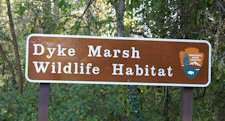
The Mount Vernon Gazette (Connection newspapers) published a front-page article on August 16, 2018, by Jerry Fill on the start of the restoration of Dyke Marsh. You can read the entire article online here.
Bringing Back Native Plants

The Mount Vernon Gazette, Connection Newspapers, published an article on our native plant restoration project. You can read it here.
Our partners are the National Park Service, Earth Sangha and the Audubon Society of Northern Virginia. We also appreciate support from the National Environmental Education Foundation and Transurban.
Sign up to help us control invasive plants and make this project a success at This email address is being protected from spambots. You need JavaScript enabled to view it..
Dyke Marsh’s Submerged Aquatic Vegetation
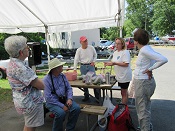
Several FODMers learned about native and non-native submerged aquatic vegetation (SAV) of Dyke Marsh and the Potomac River on July 14, 2018, when Nancy Rybicki gave a tutorial and led a paddle. Dr. Rybicki is an aquatic plant ecologist and wetlands scientist, retired from the U.S. Geological Survey. In her 37 years of studying the vegetation of the Potomac River, she has correlated the presence of submerged aquatic vegetation with water quality.
Butterflies, Dragonflies, Damselflies Delight
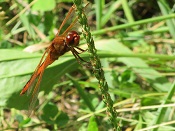
On a beautiful, 82-degree, breezy July 7, 2018, 15 FODMers studied butterflies, dragonflies and damselflies and their host plants in the Dyke Marsh Wildlife Preserve and Belle Haven Park.
It was a Needham’s skimmer (Libellula needhami) day. These showy dragonflies were whizzing around everywhere and eating midges, making for easy sightings. The males are bright reddish-orange and have a red face. The females are yellow and black. Both sexes and all ages have a black line on their abdomens and orange-tinted wings.
Exploring the Ecology of Dyke Marsh

On June 9, 2018, Dyke Marsh members and friends learned about Potomac River wetland ecosystems and the interrelationships of plants, insects, birds and other biota, on a walk on the Preserve’s Haul Road trail led by Charles Smith, expert naturalist and Chief of Fairfax County’s Stormwater Planning Division, Watershed Projects Implementation Branch. He also discussed human intervention and how native Americans used some of the marsh plants.
Restoring Habitat – 2,000 Native Plants

On June 9, 2018, twenty volunteers and National Park Service staffers planted another 1,000 native plants on a cleared .65-acre site along the Haul Road trail. The site was previously overrun with non-native or invasive plants, like English ivy, mile-a-minute and stiltgrass.


AlbertHerring-b4cc6b5cfb.jpg)



 Friends of Dyke Marsh, Inc. is a non-profit 501(c)(3) organization.
Friends of Dyke Marsh, Inc. is a non-profit 501(c)(3) organization.